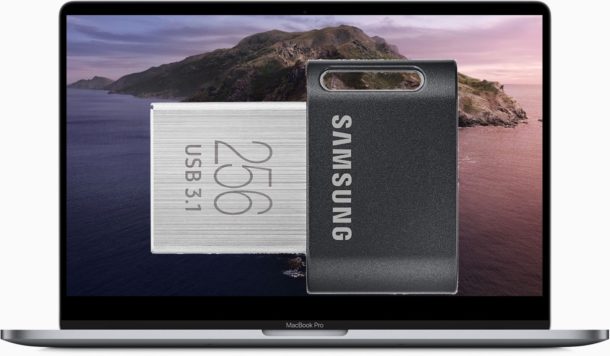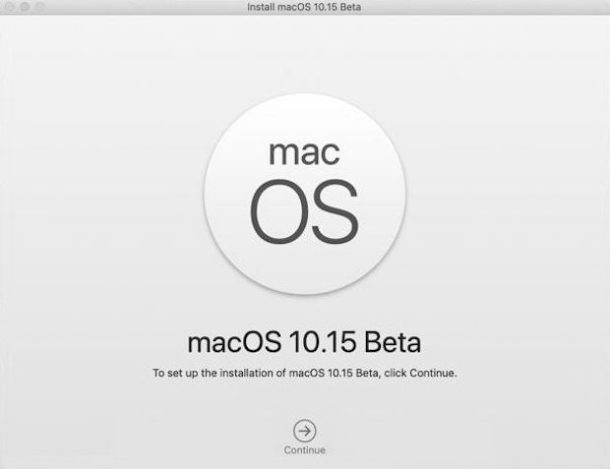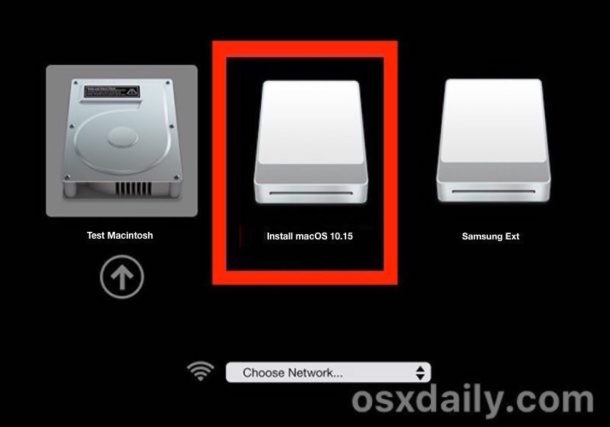How to Create a MacOS Catalina Beta USB Bootable Install Drive

Advanced Mac users can make a bootable macOS Catalina beta installer drive using a USB flash drive. This offers a simple way to install the macOS 10.15 beta release onto a test Mac, either on a separate drive or partition.
Using a boot installer drive allows for easy formatting and partitioning of disks too, making it simple to perform a clean installation of macOS Catalina 10.15 beta onto a target Mac. Of course the boot installer can also be used to upgrade an existing installation to MacOS Catalina beta as well.
This tutorial will demonstrate how to create a bootable USB install drive for MacOS Catalina 10.15 beta.
Requirements to Make a macOS Catalina 10.15 Beta USB Installer Drive
You will need the following to be able to create a bootable installer drive for macOS Catalina beta:
- USB flash drive (16GB or larger) – this will be formatted to become the bootable install drive for macOS Catalina beta
- The full “Install macOS 10.15 Beta.app” installer application residing in the /Applications/ folder on the Mac (Download macOS Catalina developer beta if you have not done so already)
- A Mac that is connected to the internet, this is necessary to download the installer
- Mac compatible with MacOS Catalina
We’re assuming you have some command line knowledge and understanding. Creating a bootable USB drive with this method requires using the Terminal, and syntax must be exact to avoid erroneously erasing the wrong drive. If you aren’t comfortable at the command line, it’s probably best to skip this.
How to Make a Bootable macOS Catalina 10.15 Beta USB Installer Drive
- Connect the USB flash drive to the Mac
- Open the “Terminal” application, found in /Applications/Utilities/ directory
- Enter the following command at the Terminal command line, replacing “UNTITLED” with the USB flash drive name of the device you want to turn into the bootable Catalina installer:
- Confirm the syntax is correct, then hit the Enter/Return key
- Authenticate with the administrator password (this is necessary to use the sudo command)
- Let the installer creation process complete, it can take a little while
For macOS Catalina FINAL version:
sudo /Applications/Install\ macOS\ Catalina.app/Contents/Resources/createinstallmedia --volume /Volumes/UNTITLED && echo Catalina Boot Drive Created
For macOS Catalina public beta:
sudo /Applications/Install\ macOS\ Catalina\ Beta.app/Contents/Resources/createinstallmedia --volume /Volumes/UNTITLED && echo Catalina Boot Drive Created
For macOS Catalina beta 2 and later:
sudo /Applications/Install\ macOS\ Catalina\ Beta.app/Contents/Resources/createinstallmedia --volume /Volumes/UNTITLED && echo Catalina Boot Drive Created
For macOS Catalina beta 1:
sudo /Applications/Install\ macOS\ 10.15\ Beta.app/Contents/Resources/createinstallmedia --volume /Volumes/UNTITLED && echo Catalina Boot Drive Created
Once the MacOS Catalina 10.15 USB installer drive has been created, it can be used like any other boot disk on a Mac.
You can immediately run the installer from the MacOS Catalina 10.15 boot drive if you want to, otherwise you can use it to boot up any Mac that is compatible with MacOS Catalina.

After the macOS Catalina 10.15 beta USB installer drive has finished being created, you can use it just like you would any other bootable Mac OS install drive. You can immediately run the installer, or eject the drive and use it on another Mac, or reboot the computer with it attached so that you can boot from the Catalina beta installer to install the update, perform a clean install, or partition the Mac to install Catalina beta onto that partition instead. There are many options available for how to use the macOS Catalina beta install drive.
Note that if you encounter a “command not found” error, it’s probably because of either a syntax error and you should check the command being run, or because the “Install macOS 10.15 Beta.app” application is not located in the /Applications folder as expected.
The above steps work for creating the macOS Catalina developer beta boot installer drive, typically the public beta has a differently named installer application and thus the command for making a bootable USB drive for macOS Catalina public beta will be slightly different. We’ll update that when it’s released and available.
How to Boot with macOS Catalina Beta USB Installer Drive
- Connect the macOS Catalina 10.15 beta install drive to to the Mac you want to install Catalina onto
- Reboot the Mac
- Immediately hold down the OPTION key upon boot, keep holding Option until you see the boot menu
- Choose the macOS Catalina 10.15 beta installer volume to boot from

After booting from the macOS Catalina installer drive, you’re free to format a target disk with Disk Utility, choose a disk to install macOS 10.15 onto, use Time Machine, access the Terminal from Recovery mode, and any other typical activity performed from a boot install drive.
Did you make a bootable macOS Catalina beta installer drive? Do you have another method to create a boot disk for macOS 10.15? Share your comments and experiences below!


I am faicng an issue on new Catalina public release with mouse and keyboard during installation.
Usign bootable USB, i get to first screen where i choose network and the disc to boot from.
Mouse and keyboard works.
I am on iMac, 2017
Then when files are loaded, after apple log and loading bar, and i get to choose where to install it, or time machine or disk utility.. both mouse and a keyboard stop working..
I can’t seem to go into recovery mode without the external drive connected as I get the -9000F Error, any way of resolving this?
When I download the Install Profile it doesn’t go to the app folder it just mounts on desktop and I don’t have a createinstallmedia to use.
Do these directions, especially the Terminal commands, need to be updated for beta 3?
No they work as is, you can make a Catalina installer USB boot drive using any of the beta or public beta versions. The only difference was between the first dev beta release and after which labeled the installers differently. There will be a new command when the final version of MacOS Catalina is released as well, however.
Can you use a partition on an external drive that is formatted APFS or do you have to format the entire external drive APFS to do this? I can get the installer to pick the partition to install to, but then when the machine reboots it goes right back to Mojave on my iMac and startup manager doesn’t seem to see the partition on the external drive.
You can install macOS Catalina into a separate container with APFS, it will share drive space with Mojave.
Another option is to install macOS Mojave onto the external drive with APFS, and then boot from that and UPDATE that external drive to MacOS Catalina (rather than install it there). That seems to work, but beware the Recovery partition situation, which many users get stuck on if trying to get away from Catalina.
The trouble is that installing macOS Catalina also does some unique things, like the Catalina system is stored on a separate volume, and that it will update your Recovery Partition too, which makes getting away from Catalina a hassle that involves erasing the entire hard drive and starting over, either with a perfect clone backup or a installer for a different MACOS release. I have also read reports of it being extra wonky with any Mac that has a T2 chip, enough so that I just think this is too early to try it out.
But macOS Catalina is very buggy, I would not try to use it at all right now personally. If you want your Mac to function as expected, stick with a stable release.
I wonder if i can try it on a middle 2011 imac ???
Roman, I have the exact same issue on my new 2019 MacBook Pro, stuck with the -9000f error
Greetings:
I am desperately trying to install 10.15 beta, following your procedure, however, i am stuck with error -9000F.
I am running ing 10.14 mojave on the 2019 MBP.
The external disk is a Samsung T5 SSD.
What am I missing?
Thanks, Roman
Can someone explain the following script
” sudo /Applications/Install\ macOS\ 10.15\ Beta.app/Contents/Resources/createinstallmedia –volume /Volumes/UNTITLED && echo Catalina Boot Drive Created ”
From what understood there has to be a command after “sudo” but since createinstallmedia is not installed we have to specify the fully path; /Applications/Install macOS 10.15 Beta.app/Contents/Resources/createinstallmedia
Does the –volume option belong to “createinstallmedia” ?
then i will create a volume in the Volumes directory.
I know that && means if the left hand side is true then execute the right hand side.
“createinstallmedia” is contained within the ‘Install macOS 10.15 Beta.app’ application which is located in the /Applications/ folder, so the command is specifying where to find the ‘createinstallmedia’ command.
The — volume flag specifies where the target volume is located, that will be the USB flash drive. We’re assuming here it’s freshly formatted and named ‘UNTITLED’ which is the default of a freshly formatted drive from Disk Utility. You don’t need to create a volume, you simply need to connect a flash drive to the USB port that you don’t mind erasing and turning into the Catalina boot drive.
And correct, && means if the aforementioned command has run, then echo that the boot drive has created.
Hope that helps!
I would like to perform a direct install from the beta installer to an APFS formatted external SSD attached to my current MacBook Pro with Mojave so that I can have a sort of dual-boot for testing.
How can I do this?
Thank you
That’s probably the best way to beta test macOS Catalina.
You’re already halfway there it sounds like, format the external SSD as APFS, then when you launch the Catalina installer, target that external SSD as the installation destination.
During system start you’ll then be able to hold OPTION to choose either Mojave (on the internal) or Catalina (on the external)
Be sure you back up your entire Mac first, just in case something goes wrong. Then it’s easy to revert if needed.